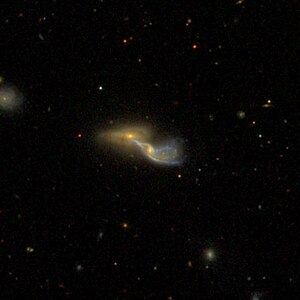NGC 4837
| Galaxy NGC 4837 |
|
|---|---|

|
|
| SDSS recording | |
| AladinLite | |
| Constellation | Hunting dogs |
|
Position equinox : J2000.0 , epoch : J2000.0 |
|
| Right ascension | 12 h 56 m 49.1 s |
| declination | + 48 ° 17 ′ 55 ″ |
| Appearance | |
| Morphological type | A: Ir B: Sd |
| Brightness (visual) | A: 13.4 mag B: 13.8 mag |
| Brightness (B-band) | A: 14.4 mag B: 14.4 mag |
| Angular expansion | A: 1.1 × 0.5 B: 1.0 × 0.4 |
| Position angle | A: 70 ° B: 90 ° |
| Surface brightness | A: 12.6 mag / arcmin² B: 12.7 mag / arcmin² |
| Physical data | |
| Redshift | 0.028186 |
| Radial velocity | 8450 km / s |
|
Stroke distance v rad / H 0 |
(381 ± 27) x 10 6 ly (116.8 ± 8.2) Mpc |
| history | |
| discovery | John Herschel |
| Discovery date | March 7, 1831 |
| Catalog names | |
| NGC 4837 • UGC 8068 • PGC 44188, 44198 • CGCG 245-006 • MCG + 08-24-011, + 08-24-012 • IRAS 12545 + 4834 • GC 3328 • H I 46 • h 1489 • I Zw 046 | |
NGC 4837 consists of two separate galaxies; NGC 4837-1 is a 13.4 likes bright irregular galaxy of Hubble type Ir; NGC 4837–2 a 13.8 mag bright spiral galaxy of the Hubble type Sd. Both galaxies form a gravitational double galaxy in the constellation of the Hounds and are about 381 million light years away from the Milky Way.
They were discovered on March 7, 1831 by John Herschel with an 18.7-inch reflecting telescope, which only “A rather doubtful object; haze ”noted. Due to this observation, an entry in the catalog was made only once; so far only MGC and PGC have assigned a further, second number.
